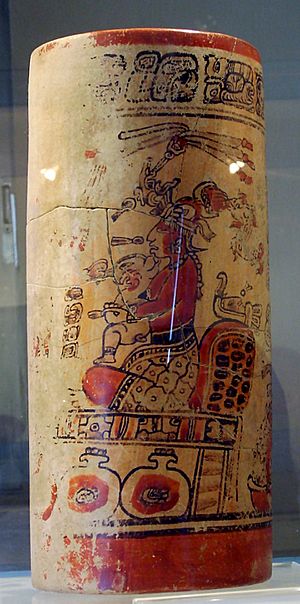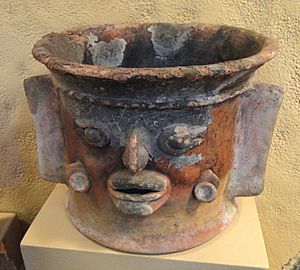Maya ceramics facts for kids

Maya ceramics are special pots and other items made from clay by the ancient Maya people in Mesoamerica. They used these items for many things, like storing food and drinks, and also as beautiful art. Some pots were simple for everyday use, while others were fancy and colorful for important people.
The Maya made different types of ceramics, including bowls, plates, and cylinders. Simple pots often had just one color. More colorful pots, called polychrome pottery, were harder to make. Important Maya people often used these fancy pots to show their high status.
Over time, the Maya added cool features to their ceramics. For example, some large bowls had small clay balls inside. This meant they could hold food and also be shaken to make music during parties!
Archaeologists have even found that some Maya ceramics were used for making salt. They found many similar ceramic cylinders with salt-making tools, suggesting they were used to mass-produce salt from salty water.
Contents
Decorating Maya Pottery
Common people's pottery usually had simple designs that matched how they were used. But pots made for palaces were much more detailed. They had carvings or colorful paintings with hieroglyphs. These writings often said what the pot was for, who owned it, and sometimes even the artist's name!
For example, cylindrical bowls used for drinking cacao (a chocolate drink) often showed the Q. guatemalteca flower. This flower was used to make the cacao drink taste even better. The designs on pots often showed rituals, gods, or daily life scenes. Rulers were sometimes shown next to gods, looking almost as powerful as them. Other pots told stories, with glyphs that might have been guides for songs or special texts.
For many Maya potters, the pictures and designs were more important than the pot's shape. Cylindrical vases and plates were popular because they had a lot of space for storytelling through art. As painting became more complex, the shapes of the pots stayed quite simple.
Different Maya regions had their own favorite colors and symbols. In Holmul, pottery often used reds and oranges on a white background. Black backgrounds often showed supernatural beings or the underworld. In Tikal, a symbol called the Tikal Dancer was popular. This dancer shows the young Maize God with his arms out and one leg bent. The Maize God was very important to the Maya because he represented their main food and also new life.
Some pots had special "rattle feet." These were hollow cylinders at the bottom of the plate with a ball inside. When shaken, the plate would rattle, making music for rituals. Larger pots (over 0.3 meters wide) were often used for big feasts, while smaller ones, like jars, were for storage.
Pottery in Maya Society
Maya ceramics were made from two main materials: limestone and volcanic ash. Most of the Maya land had limestone, which provided calcite. Pots made from limestone were often given as gifts to make friends with nearby groups. These pots are usually found in smaller areas.
Pots made from volcanic ash were found in more places. This is because important Maya people might have given them as gifts to make bigger alliances through the Maya trade routes.
The Maya were famous for their amazing pottery. They even used special pots in their sacrifice rituals, which were a way to pray for rain and good crops.
During the Maya Classic Period, important Maya people used ceramics in many ways. They gave them as gifts to leaders from other places and used them in big feasts. Special pottery was also made for the graves of nobles. Not just anyone could make these important pots; the artists needed to know a lot about Maya history and myths.
These fancy ceramics showed detailed scenes of palace life. The artists made sure to show the elite because they were the main customers! Near the rim of each pot, it would say what was inside (like a drink or food) and who owned it. Sometimes, the rim also had special symbols that might show where the pot was made or where the scene on it took place.
Because these ceramics were traded and given as gifts, they ended up in many different places. For example, many pots from Tikal have been found in Teotihuacan, showing how merchants traveled and traded between cities. Experts study the writing, drawings, and hieroglyphs on these pots because they tell us about different people and cultures. For everyday use, simpler, single-colored pots were made in large numbers for everyone.
How Maya Pottery Was Made
The Maya had special ways to create, carve, paint, and design their pottery. First, they had to find the right materials for clay and temper. Temper is like small pieces of rock, ash, or sand that are mixed with the clay to make the pottery stronger.
Today, Maya people in Guatemala, Belize, and southern Mexico still make beautiful ceramics. They find their clay in river systems in the highlands, which are rich in volcanic rock and ash. It's thought that the ancient Maya got their clay in similar ways.
Once the clay and temper were gathered, the pottery making began. The maker would mix the clay with the temper until it was just right. Then, they would start shaping the pot.
The Maya did not use a potter's wheel. Instead, they used "coil" and "slab" techniques.
- The coil method involved rolling clay into long ropes and winding them up to form the pot's shape. Then, they smoothed the coils together to make strong walls.
- The slab method used flat, square pieces of clay to create boxes or parts like feet or lids for pots.
After shaping, the pot was left to dry until it was "leather hard" (partially dry but still workable). Then, it was painted, carved, or covered with a special clay mixture called "slip." The final step was firing the pot. The Maya used outdoor kilns, which were fired with wood, charcoal, or even grass.
Like the Ancient Greeks, the Maya made clay slips from different clays and minerals. These slips were used to decorate the pottery. By the 4th century, they could make many colors, including yellow, purple, red, and orange. However, some Maya painters used only black, red, and sometimes cream. This style is called "Codex-style" because it looks like the style of their ancient books.
From the 5th century onwards, the Maya started using a technique called "post-firing stucco" from Teotihuacan. They made a thin paste from quicklime and added mineral pigments to create rich blues and greens. The famous Maya blue was first used for rituals. It was made by mixing indigo, copal, and palygorskite and burning them as incense, which left a blue color. This post-fire stucco was often combined with painting and incising. Incising means carving deeply or lightly into partially dried clay to make detailed designs. This was very popular during the Early Classic Period.
How Maya Pottery Changed Over Time

The Maya culture changed a lot over centuries, and so did their pottery. Archaeologists have found different stages of ceramic styles that match the Maya timeline.
- Middle Preclassic (900/800-250 BC) and Late Preclassic (250 BC- AD 250): Very early Maya people used gourds (like hard-shelled squash) as containers. The first clay pots looked a lot like these gourds and were decorated simply. Later, in the Late Preclassic period, many pots had "tetrapod mammiform supports." These were four legs under the pot that held it up. These unique pots often had cream-on-red stripes.
- Early Classic (AD 250-550): The Maya started using polychrome slip paint, meaning they used many different colors to decorate their pots. This colorful style became very common for Maya potters, marking the start of the Classic Period. Most Early Classic ceramics were still monochrome (one color). Fancy polychrome pots were mainly for the elite, probably made by and for other important people.
A new style of pot appeared: the lidded basal flange bowl. These bowls usually had a knob on top shaped like an animal or human head. The body of the pot would be painted with the rest of the animal or human. Many of these pots also had mammiform supports (legs). These special pots are often found in good condition because they were used as burial goods.
Images for kids
See also
 In Spanish: Cerámica maya para niños
In Spanish: Cerámica maya para niños




